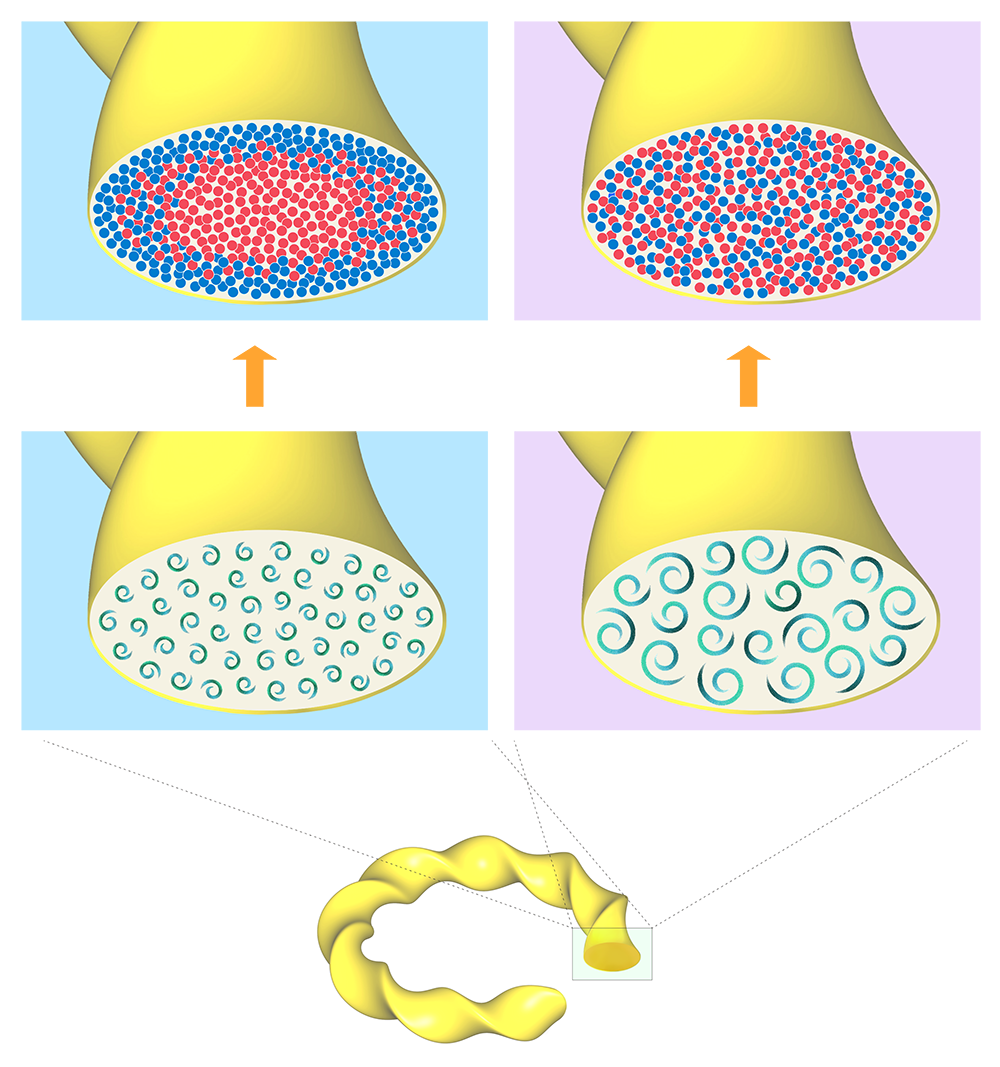Discovering Turbulence to Help Plasma Mixing
The mixing state of hydrogen and deuterium in plasma was measured for the first time in the world in a mixed plasma experiment using hydrogen and deuterium in a large helical device (LHD). It was found that the hydrogen and deuterium plasmas do not mix when their size of the plasmas is small but do when they are large, caused by the heating process. This achievement gives a guideline for the "mixed state" necessary for hydrogen isotope mixed plasmas used in nuclear fusion power generation.

The mixing state of hydrogen and deuterium in plasma was measured for the first time in the world in a mixed plasma experiment using hydrogen and deuterium in a large helical device (LHD). It was found that the hydrogen and deuterium plasmas do not mix when their size of the plasmas is small but do when they are large, caused by the heating process. This achievement gives a guideline for the "mixed state" necessary for hydrogen isotope mixed plasmas used in nuclear fusion power generation.
In nuclear fusion power generation, the energy generated by the fusion reaction between deuterium and tritium in the plasma is extracted. For the fusion reaction to occur efficiently, it is necessary to maintain a state in which the density of deuterium and tritium are equally mixed. In the Large Helical Device (LHD), experiments of mixed plasmas of "hydrogen" and "deuterium" were conducted to simulate those of "deuterium" and "tritium" that will be used in future fusion power generation.
The research team developed the measurement of two density ratios in the mixed plasmas of hydrogen and deuterium. To obtain the density ratio, they used a method in which a fast particle beam is injected into the plasma, and the wavelength distribution of the light emitted from the plasma is analyzed (bulk charge exchange spectroscopy*2). In addition, they developed a method to separate the light emitted from hydrogen and deuterium, whose wavelength difference is tiny, which had been considered difficult in the past, and succeeded in obtaining the density ratio.
As a result of measuring the spatial distribution of the density ratio using this method, they discovered that hydrogen and deuterium transition from an "unmixed" state to a "mixed" state. In addition, they compared experimental results with simulation results using a supercomputer. It is found that hydrogen and deuterium cannot be mixed in turbulence with a small size but are mixed when turbulence with a large size becomes stronger. This result shows that it is possible to control the mixing state of isotopes, if the size of the plasma turbulence can be controlled.
Since it is difficult to directly supply fuel to the central plasma in a fusion device, it is easy to control the density ratio of the surrounding plasma. Still, it isn't easy to maintain the density ratio of the central plasma, which contributes to the fusion reaction. With this achievement, we have obtained essential knowledge that leads to controlling the density ratio in the plasma center.
This research was carried out by a research group led by Katsumi Ida and Yoshiki Nakata at the National Institute for Fusion Science, in collaboration with Koutaro Yamazaki at the Institute of Applied Mechanics Kyushu University.
The results of this research were published in Physical Review Letters, a journal by the American Physical Society on 14 January 2020, as a preliminary report, and Nuclear Fusion, a journal on controlled thermonuclear fusion by the International Atomic Energy Agency on 23 November 2020, for detailed information.
Publication
- K.Ida et al., "Transition between isotope-mixing and non-mixing states in hydrogen-deuterium mixture plasmas", Physical Review Letters 124 (2020) 02500278.[NIFS Repository]
- K.Ida et al., "Characteristics of plasma parameters and turbulence in the isotope-mixing and non-mixing states in hydrogen-deuterium mixture plasmas in a large helical device", Nuclear Fusion 61 (2020) 016012.[NIFS Repository]
Glossary
*1 Turbulence:
As plasma is heated, small vortex flows are formed as the temperature gradient increases. Turbulence: When plasma is heated, as the temperature gradient increases, small vortex flows are formed. These small vortex flows vary in size and are irregularly lined up, called turbulent flows. When turbulence occurs, the temperature rise is disturbed, and the vortices stir up the plasma particles.
*2 Bulk Charge Exchange Spectroscopy:
A method of measuring the isotope density ratio (density ratio of light hydrogen to deuterium) inside a plasma using light emitted from collisions between fast neutral particles (atoms) injected into the plasma and ions in the plasma.
